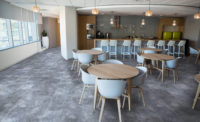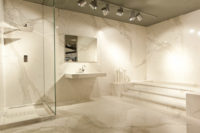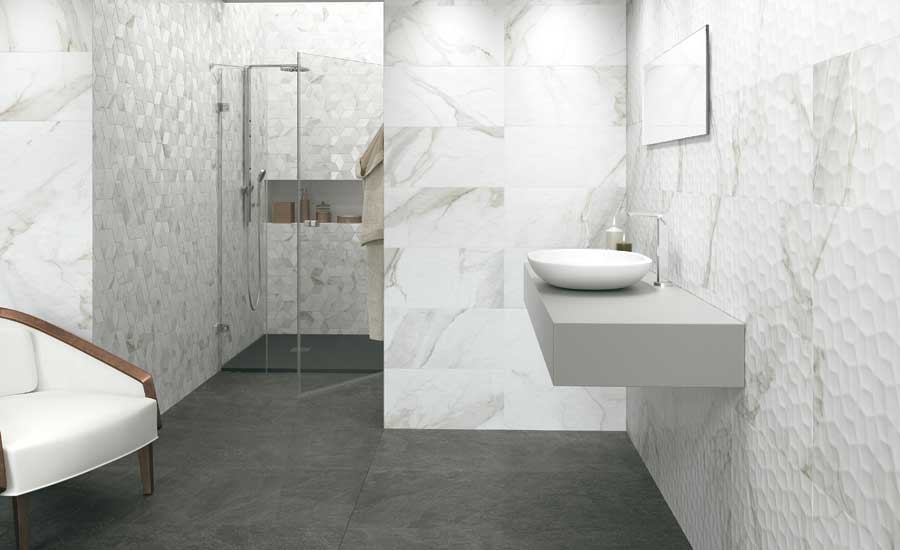Trends in Large Format Tile



Florida Tile’s PreciousHDP rectified porcelain tile replicates the look of Calacatta marble. It is made in the USA with 40% pre-consumer recycled content.









Thanks to advancing technology, large-format tile is quite literally becoming bigger than ever. Members of every corner of the industry—from manufacturers and retailers to designers and installers—are coming together to embrace this product’s potential for continued success.
“From fabric replicas to wood-inspired designs to intricate mosaics, tile and stone products are taking on new forms and, as a result, unleashing a world of design possibilities for residential and commercial professionals,” said Barbara Haaksma, Emser Tile vice president of marketing. “It’s exciting to lead industry conversations surrounding the important role tile and stone play in creating on-trend, sustainable spaces.
Porcelain tile panels are one category of large-format porcelain that is on a fast growth trajectory, with introductions measuring nearly 3 x 10 feet and profiles as lean as 3 millimeters for walls and 5.6 millimeters for wall or floor installations. Known as “thin tile”, industry installation standards use the term “gauged” to cover a range of precise thicknesses that can carry different loads and be used in different ways, taking a similar approach to standardized wire gauges and gauged sheet metal, according to the Tile Council of North America (TCNA).
“From fabric replicas to wood-inspired designs to intricate mosaics, tile and stone products are taking on new forms and, as a result, unleashing a world of design possibilities for residential and commercial professionals.”
– Barbara Haaksma
In April, Daltile introduced Panoramic porcelain surfaces, a 10.5 x 5.3-foot panel that comes in 6 mm and 12 mm thicknesses. Stocked in eight locations around the country, the panels come in polished or honed finishes. “These slabs are ideal for floors, walls and countertops and are durable and low-maintenance,” said Kim Albrecht, senior brand marketing manager, Daltile.
Lindsey Waldrep, vice president of marketing for Crossville, said the installation and cost advantages of these large panels are creating major advantages for the marketplace. The company continues to have success with its Laminam porcelain panel product. “As building materials shift, morph and change, our Laminam collections are truly enlightening products,” Waldrep said. “It allows designers to utilize porcelain tiles in new ways and with new thinking in so many applications.”
“I love this product,” said interior designer Patricia Gaylor, owner of Eco Interiors in Las Vegas, who spoke on a design panel at The International Surface Event (TISE). “I’ve seen it come around for a few years, and I honestly believe it is the very beginning of the way we look at tile. I do a lot of renovations on older homes and many times removing tile is not an option. Having the ability to go over a particular tile in residential application is an advantage.”
Anne Rue of Anne Rue Interiors in Sanford, Fla., said she specifies large-format tile panels for the hotel makeover projects she designs for the Travel Channel hit series Hotel Impossible.
“When you’re doing a renovation for TV, especially for TV, even though you have a week to film, you really only have three and a half days to produce a project,” Rue said. “We would be on a project where there is flooring existing. We wouldn’t have time to do demolition and take all the tile out, so Laminam worked well for us. It’s such a large product and such a thin product; it covers a lot of space and can go over existing tile.”
Waldrep said that although large porcelain panels are not yet being showcased in many retail showrooms, which often have standard 8-foot ceilings, there are opportunities for retailers to display them creatively and market their benefits.
“In a showroom, I can see this done with a beautiful fireplace wall or backsplash so you can feel the texture,” Gaylor noted. “You can also do a cutaway with some old tile underneath and the adhesive so that you can see and stand on the new product.”
Florida Tile responded to the growth of the large-format tile market in 2016 by expanding distribution and adding rectification to its production line. “For us, it’s not technology [growing the market] as it is manufacturing capabilities like the rectification,” said Sean Cilona, director of marketing and product development, Florida Tile. “It’s not anything that is a new technology for the industry, but it is for us, so it allows us to manufacture larger formats, like 18 x 36 and 24 x 24. We can cut 18 x 36 in our factory to make plank sizes that are popular.”
Florida Tile’s sister company Cotto d’Este, a premium brand focused on high-end residential and commercial projects, is building business with large-format tile with thin tile at 1x 3 meters and regular thickness tile in 36 x 36-inch sizes.
As with any new and burgeoning materials category, technology moves forward and there is a transition period where standards and installers must catch up.
“Interest in gauged tiles has been growing exponentially the last few years,” said Eric Astrachan, TCNA executive director. “Such growth encourages more products to enter the marketplace, but without standards, tile consumers would have no way to know what to expect in terms of performance. Installers especially were asking for standards to allow for installation practices to be developed based on consistent tile properties. Without such, it was feared that problems resulting from an undefined range of products could have hindered growth of this exciting market segment.”
In April, TCNA Laboratory Services team announced two new standards: ANSI A137.3, the American National Standard Specifications for Gauged Porcelain Tiles and Gauged Porcelain Tile Panels/Slabs, and its companion, ANSI A108.19, Interior Installation of Gauged Porcelain Tiles and Gauged Porcelain Tile Panels/Slabs by the Thin-Bed Method bonded with Modified Dry-Set Cement Mortar or Improved Modified Dry-Set Cement Mortar. They define two classes of gauged tile products—those for wall applications from 3.5 to 4.9 mm and for floor and wall applications from 5.0 to 6.5 mm. ANSI A137.3 standardizes the minimum required properties for the products themselves and ANSI A108.19 standardizes the methodologies for installing the products in interior installations by the thin-bed method with specific mortars.
These standards, developed for the benefit of all tile consumers, are the result of a multi-year consensus process of the ANSI Accredited A108 Standards Committee, which maintains a broad and diverse group of participants reflecting stakeholder interests in all aspects of the tile industry.
Larger porcelain tile sizes for the floor are also fueling growth of larger ceramic tile sizes for the wall. “Ceramic is a growing commodity in the U.S.,” Cilona said. “Tile is taking its share. We have seen a growth of ceramic wall tile, and if you look at offerings this year, we have three offerings that have floor-wall combinations and not just dedicated porcelain, even though we have that.”
Cilona said the growth of larger ceramic wall tile reflecting style preferences in the market. “Traditionally we’ve seen people prefer a glossy wall tile in a bathroom setting, where in the last few years, the style of bringing a matte porcelain up the wall looks contemporary, but it’s not always the look people are going for,” he said. “The traditional looks of a glossy wall is still in demand, but we are refining the graphics, using more digital technology, making them more realistic and also using larger formats.”
Large-format tile is also opening opportunity for more outdoor installations as open floor plans are the norm in residential space planning. Porcelain tile interpreting wood, stone and cement will be popular in the kitchen and moving out onto the patio, according to Albrecht. These tiles can be installed directly on gravel, sand or dirt. Daltile introduced Saddle Brook XT, an outdoor-safe wood look, in 2016 and 2017 will see more options for this type of seamless living. Another successful product is Slate Attaché with the same outdoor technology and easy cleanability.
MSI’s Livingstyle Porcelain is an indoor/outdoor large-format tile collection with pavers, designed to capture the raw beauty of limestone. From kitchens and living spaces to terraces and walkways, this durable lineup comes in two large-format sizes (18 x 36-inch tiles and 24 x 24-inch pavers), true-to-stone colorways, and coordinating bullnose trim. “We remain focused on next generation design trends that combine high-quality materials with innovative technology to bring authenticity, durability, and affordability to all the varied global styles we offer,” said Rup Shah, president at MSI.
Looking for a reprint of this article?
From high-res PDFs to custom plaques, order your copy today!











